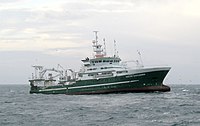
Photo from wikipedia
Abstract Size-selective grids in the Barents Sea trawl fisheries have demonstrated large variation in sorting capacity. When combined with dynamic catch-control systems for regulating catch quantity, surplus fish are washed… Click to show full abstract
Abstract Size-selective grids in the Barents Sea trawl fisheries have demonstrated large variation in sorting capacity. When combined with dynamic catch-control systems for regulating catch quantity, surplus fish are washed out at the surface. The objective of this study was to develop a codend concept that releases more undersized fish than the most commonly used size–selectivity device in the Barents Sea trawl fishery (flexigrid combined with a two-panel 130 mm codend). Fishing with twin trawls, a four-panel 153 mm codend concept with short lastridge ropes to force open meshes was compared with a flexigrid combined with a 130 mm mesh codend, in terms of size selectivity for cod (Gadus morhua), haddock (Melanogrammus aeglefinus) and saithe (Pollachius virens). Compared to the grid–codend setup, the four–panel codend with short lastridge ropes retained about half of 54.5–59.4 cm gadoids, with catches of undersized cod, haddock and saithe reduced by 90 (ci = 85–94), 92 (ci = 88–96) and 86 % (ci = 79–92) respectively. The study demonstrated that the four-panel codend concept releases more undersized fish than the flexigrid-codend combination.
Journal Title: Fisheries Research
Year Published: 2020
Link to full text (if available)
Share on Social Media: Sign Up to like & get
recommendations!